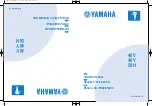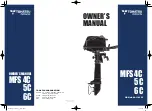
1-14
SAFETY
pins, eye-washing
cup, and a hot water bot-
tle.
The supplies in the kit should include:
assorted
bandages
in addition
to the various
sizes of "band-aids",
adhesive
tape,
absorb-
ent cotton,
applicators,
petroleum
jelly, an-
tiseptic
(liquid
and
ointment),
local
oint-
ment,
aspirin,
eye ointment,
antihistamine,
ammonia
inhalent,
sea-sickness
pills,
ant-
acid pills, and a laxative.
You may want to
consult
your family
physician
about
includ-
ing antibiotics.
Be sure your kit contains
a
first-aid
manual
because
even
though
you
have taken
the Red Cross course,
you may
be
the
patient
and
have
to
rely
on
an
untrained
crew for care.
Fire Extinguishers
All fire
extinguishers
must bear Under-
writers
Laboratory
(UL) "Marine
Type" ap-
proved
labels.
With the
UL certification,
the extinguisher
does
not
have
to
have
a
Coast
Guard
approval
number.
The Coast
Guard classifies
fire extinguishers
according
to their size and type.
Type B-1or B-II Designed for extinguishing
flammable liquids. This type extinguisher is
required on all motorboats.
The Coast
Guard considers
a boat having
one or more of the following conditions
as a
"boat of closed construction"
subject
to fire
extinguisher
regulations.
A suitable
fire
extinguisher
should be mounted
close
to the helmsman
for
emergency
use.
1-
Inboard engine or engines.
2- Closed
compartments
under
thwarts
and seats
wherein
portable
fuel
tanks
may
be stored.
3-
Double bottoms
not sealed to the hull
or
which
are
not
completely
filled
with
flotation
materials.
4- Closed living spaces.
5- Closed
stowage
compartments
in
which combustible
or flammable
material
is
stored.
6- Permanently
installed
fuel tanks.
Detailed
classification
of fire
extingui-
shers is by agent and size:
B-1 contains 1-1/4gallons foam, or 4 pounds
carbon
dioxide,
or 2 pounds
dry chemical
agent, or 2-1/2 pounds Halon.
B-II contains
2-1/2 gallons foam, or 15
pounds carbo dioxide, or 10 pounds dry chemi-
cal agent, or 10 pounds Halon.
The
class
of
motorboat
dictates
how
many
fire
extinguishers
are
required
on
board.
One B-II unit can be substituted
for
two
B-1 extinguishers.
When the
engine
compartment
of
a
motorboat
is equipped
with a fixed (bull t-in) extinguishing
system,
one less portable
B-1 unit is required.
Dry chemical
fire extinguishers
without
At least one gallon
of
emergency
fuel should be kept
on board in an approved
container.
Summary of Contents for 4906B 4HP 1969
Page 5: ......
Page 87: ...3 46 POWERHEAD Exploded drawing of a 7 5 hp powerhead 1956 58 with principle parts identified...
Page 88: ...CYLINDER BLOCK 3 47 HEAD GASKET RING...
Page 90: ...CYLINDER BLOCK 3 49 THERMOSTAT EXHAUST COVER The...
Page 137: ...4 46 FUEL LEVER AND LOW SPEED...
Page 153: ...4 62 FUEL Exploded view of a pressure tyoe fuel tank with major parts identified...
Page 157: ...4 66 fUEL...
Page 412: ...A 16 APPENDIX Wire Identification 33 hp with Generator 1965 67...
Page 413: ...APPENDIX A 17 o C...
Page 414: ...Wire Identification 33 hp with Generator 1969 70...
Page 415: ...APPENDIX A 19 Wire Identification 35 hp 1957 59...
Page 416: ...A 20 APPENDIX Wire Identification 40 hp Standard Shift with Generator 1960 66...
Page 417: ...APPENDIX A 21 UJ cc b Wire Identification 40 hp Standard Shift with Generator 1967 68...
Page 419: ...APPENDIX Wire Identification 40 hp Electric Shift with Generator 1961 66 A 23...
Page 420: ...A 24 APPENDIX C 00 Wire Identification 40 hp Electric Shift with Generator 1967 68...
Page 421: ...Wire Identification 40 hp Electric Shift with Generator 1969 70...
Page 422: ...NOTES NUMBERS...














































